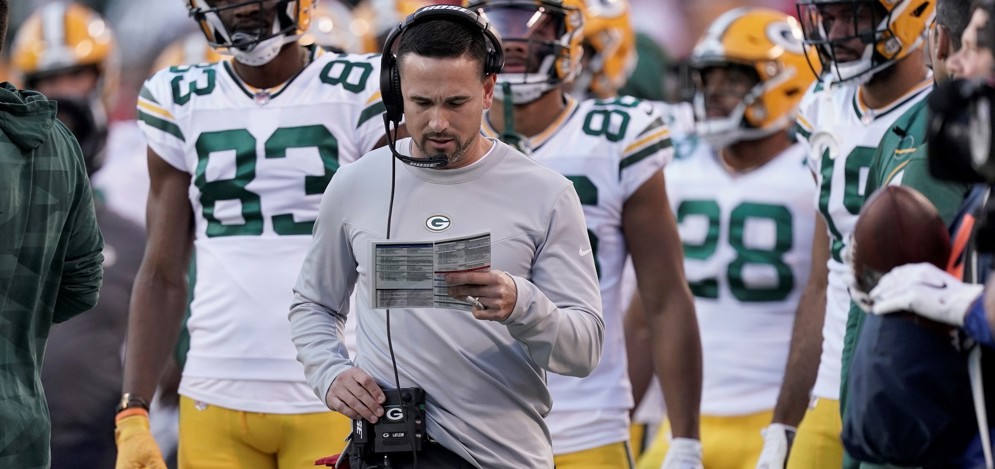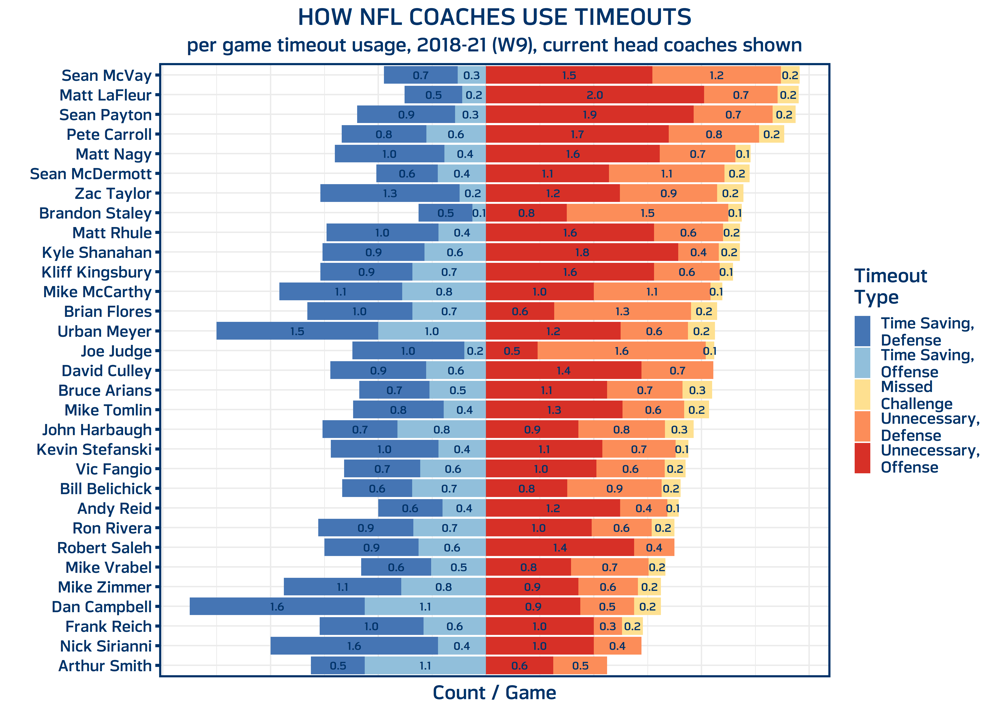The Extra Point How do NFL coaches use their timeouts?
November 10, 2021

NFL teams receive three timeouts each half. Timeouts can be used strategically to manage the clock or to avoid a penalty or unwelcome formation. Given the value of timeouts during end-of-game scenarios — ESPN Sports Data Scientist Brian Burke estimated that each second half timeout is worth about 3% in win probability — coaches are generally reluctant to call a timeout until the final minutes of each half.
To compare how current NFL coaches use their timeouts, we began by categorizing each timeout into one of the following categories:
Timeouts worth saving
These timeouts typically are called later in a half to conserve time on the game clock.
Time Saving, Offense: Called when a team is on offense, these timeouts typically come at the end of a half, and are called to stop the clock immediately after a play ends in order to conserve time on the game clock to reset ahead of the next play.
Time Saving, Defense: Called when a team is on defense, these timeouts typically come at the end of a half, and are called to stop the clock immediately after a play ends in order to try to get the ball back or conserve time on the game clock.
Timeouts coaches would like to have back
These timeouts typically are called earlier in a half when something doesn’t go as planned.
Unnecessary, Offense: Called when an offense is trying to avoid a delay of game or an uncertain play call.
Unnecessary, Defense: Called when a defense is dealing with substitution issues or when a coach is not confident in a defensive set.
Lost Challenges: Teams are docked a timeout after each failed instant replay challenge initiated by the head coach.
Other timeouts
Less than 5% of timeouts are called for other reasons, including timeouts for injured players with less than two minutes in a half, timeouts called right before the end of a half with a stopped clock, or timeouts meant to “ice the kicker.”
The following chart shows the first two categories of timeouts, plotted for each of the 31 current non-interim head coaches on a per-game basis from 2018–21 (Week 9).
The plot is ordered in terms of number of unnecessary timeouts (shown in red, orange, and yellow).

Current Rams head coach, Sean McVay, leads all coaches with 2.9 unnecessary timeouts per game (1.5 on offense, 1.2 on defense, and 0.2 in missed challenges), with Packers coach Matt LaFleur (2.9) and Saints coach Sean Payton (2.8) right behind. First-year head coaches Arthur Smith of the Falcons (1.1 per game) and Nick Sirianni of the Eagles (1.4) are most judicious with their timeouts.
First-year coaches Dan Campbell of the Lions (2.7 time saving timeouts per game) and Urban Meyer of the Jaguars (2.5) use the most time-saving timeouts, though much of that is likely driven by each team’s circumstance (the Lions are 0-8 and the Jaguars are 2-6).
Knowing each coach’s background gives additional context regarding offensive versus defensive timeout usage. The three head coaches with the highest total of unnecessary offensive timeouts are all former offensive coordinators — LaFleur, Payton, and 49ers coach Kyle Shanahan. The three coaches with the highest total of unnecessary defensive timeouts include former special-teams coordinator (Joe Judge of the Giants, 1.6 per game) and former defensive coordinators (Brandon Staley of the Chargers, 1.4 per game, and Brian Flores of the Dolphins, 1.3 per game).
Crowd noise may also play a role. If we compare by season and team — both home and away — we see that the 2020 season without fans featured 0.39 fewer unnecessary offensive challenges per game, relative to 2018, 2019, and 2021. And when there are fans, visiting teams call 0.19 more unnecessary offensive timeouts per game than home teams, a difference that is consistent across seasons.